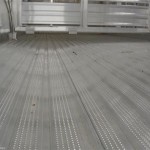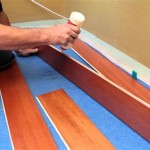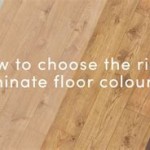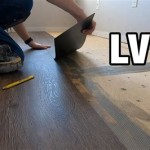How To Remove Super Glue From Vinyl Flooring
Super glue, also known as cyanoacrylate adhesive, is a household staple appreciated for its rapid bonding and strong adhesive properties. However, its tendency to bond quickly and firmly becomes problematic when it accidentally adheres to surfaces where it's not intended, such as vinyl flooring. Removing super glue from vinyl requires patience and the application of appropriate techniques to avoid damaging the flooring material itself. This article provides a comprehensive guide on methods for safely and effectively removing super glue from vinyl flooring.
Understanding the Nature of Super Glue and Vinyl Flooring
Before attempting removal, it is crucial to understand the properties of both super glue and vinyl flooring. Super glue bonds through polymerization, a chemical reaction that forms long chains of molecules, creating a rigid and durable bond. Vinyl flooring, typically composed of polyvinyl chloride (PVC), is known for its durability, water resistance, and relative ease of maintenance. However, vinyl is susceptible to damage from harsh chemicals and abrasive cleaning methods. Applying excessive force or using inappropriate solvents can lead to scratching, discoloration, or even melting of the vinyl surface. Therefore, a gentle and methodical approach is essential for successful super glue removal.
It's also important to note that different types of vinyl flooring exist. Sheet vinyl, vinyl tile, and luxury vinyl plank (LVP) all have slightly different compositions and surface textures. While the basic principles of super glue removal remain consistent, the specific techniques and products used may need to be adjusted based on the flooring type. For instance, heavily textured vinyl might trap super glue more aggressively, requiring more thorough cleaning. Before proceeding with any method, it is advisable to test the chosen solvent or technique on an inconspicuous area of the vinyl floor to ensure it does not cause discoloration or damage.
Initial Assessment and Preparation
The first step is to assess the extent of the super glue spill. Consider factors such as the size of the affected area, the thickness of the glue deposit, and the length of time the glue has been allowed to dry. Freshly spilled super glue may be easier to remove than glue that has been allowed to cure for an extended period. Additionally, if the glue is still wet, avoid spreading it further by blotting gently with a clean, dry cloth. Do not rub the area, as this will only worsen the situation by driving the glue deeper into the vinyl's texture.
Before attempting any removal techniques, gather the necessary supplies. These typically include:
*A plastic scraper or putty knife (avoid metal, as it can scratch the vinyl)
*Clean, soft cloths
*Warm water
*Dish soap (mild)
*Isopropyl alcohol (rubbing alcohol)
*Acetone (nail polish remover, use with caution)
*Cotton swabs or cotton balls
*Protective gloves
*Eye protection
Wearing protective gloves and eye protection is essential to prevent skin and eye irritation from solvents like acetone and isopropyl alcohol. Ensuring adequate ventilation in the work area is also important, especially when using solvents with strong fumes.
Methods for Super Glue Removal
Several methods can be used to remove super glue from vinyl flooring, ranging from gentle approaches to more aggressive techniques. It is recommended to start with the mildest method and gradually escalate if necessary.
Method 1: Soapy Water and Gentle Scraping
This method is best for removing thin layers of freshly dried super glue or for softening thicker deposits before attempting other removal techniques. Begin by mixing a small amount of mild dish soap with warm water to create a soapy solution. Soak a clean cloth in the solution and apply it to the affected area, ensuring the glue is thoroughly saturated. Allow the soapy water to sit for several minutes to help soften the glue.
After soaking, use a plastic scraper or putty knife to gently lift the edges of the glue. Work slowly and carefully, applying pressure gradually. Avoid forcing the scraper, as this can scratch the vinyl surface. If the glue resists removal, reapply the soapy water and allow it to soak for a longer period. Continue scraping until the majority of the glue is removed. Once the bulk of the glue is gone, wipe the area with a clean, damp cloth to remove any remaining residue. Dry the area thoroughly with another clean cloth.
Method 2: Isopropyl Alcohol
Isopropyl alcohol, commonly known as rubbing alcohol, is a more potent solvent than soapy water and can be effective in dissolving super glue. However, it should be used with caution, as it can sometimes discolor or damage certain types of vinyl flooring. Always test isopropyl alcohol on an inconspicuous area before applying it to the visible area.
To use isopropyl alcohol, soak a cotton ball or swab in the alcohol and apply it directly to the super glue. Allow the alcohol to sit for several minutes to penetrate and soften the glue. Use a plastic scraper to gently lift the edges of the glue, working slowly and carefully. Reapply the alcohol as needed to keep the glue saturated. After removing the glue, wipe the area with a clean, damp cloth to remove any residue. Dry the area thoroughly.
If the super glue covers a large area, you can soak a cloth in isopropyl alcohol and place it over the affected area for a longer period (e.g., 15-30 minutes). This will allow the alcohol to thoroughly penetrate and loosen the glue. Be sure to monitor the area closely to ensure the alcohol does not damage the vinyl.
Method 3: Acetone
Acetone, the active ingredient in many nail polish removers, is a powerful solvent that can effectively dissolve super glue. However, it is also highly potent and can easily damage or discolor vinyl flooring. Acetone should be used as a last resort and only after testing it on an inconspicuous area. It is crucial to exercise extreme caution when using acetone and to follow safety precautions carefully.
When using acetone, wear protective gloves and eye protection and ensure adequate ventilation. Soak a cotton ball or swab in acetone and apply it directly to the super glue. Allow the acetone to sit for a very short period (e.g., a few seconds) before attempting to scrape the glue. Work quickly and carefully, as acetone can evaporate rapidly and potentially damage the vinyl if left on for too long. Use a plastic scraper to gently lift the edges of the glue. If the glue is particularly stubborn, reapply a small amount of acetone, but avoid prolonged exposure.
After removing the glue, immediately wipe the area with a clean, damp cloth to remove all traces of acetone. Dry the area thoroughly. If the vinyl appears discolored or damaged after using acetone, consult a flooring professional for advice on repair or restoration. It's also important to note that some vinyl floors have a protective coating that acetone can dissolve, so it's important to test in an inconspicuous area first.
Post-Removal Cleaning and Maintenance
After successfully removing the super glue, it is essential to thoroughly clean and maintain the affected area of the vinyl floor. This will help to remove any residual solvent or glue residue and restore the floor to its original appearance.
Start by wiping the area with a clean, damp cloth to remove any remaining traces of solvent. Next, wash the area with a mild solution of dish soap and warm water. Use a soft cloth or sponge to gently scrub the area, paying attention to any textured surfaces that may trap residue. Rinse the area thoroughly with clean water to remove all traces of soap.
Finally, dry the area thoroughly with a clean, dry cloth. This will help to prevent water spots or stains from forming on the vinyl surface. For added protection, you can apply a vinyl floor polish or sealant to the area. This will help to restore the shine and protect the floor from future damage.
Regular cleaning and maintenance are essential for prolonging the life of vinyl flooring and preventing future stains and damage. Sweep or vacuum the floor regularly to remove dirt and debris. Mop the floor with a mild cleaning solution as needed. Avoid using abrasive cleaners or harsh chemicals, as these can damage the vinyl surface.
By following these steps, one can effectively remove super glue from vinyl flooring while minimizing the risk of damage. Remember to exercise patience and caution, and always test any cleaning solutions or solvents on an inconspicuous area before applying them to the visible area. Proper preparation, careful execution, and thorough post-removal cleaning will help to restore the vinyl floor to its original condition.

How To Remove Super Glue From Laminate Flooring 14 Steps

How To Remove Glue Residue From Vinyl Flooring

Removing Glue Or Adhesive From Hardwood Floors The Speckled Goat

Removing Glue Or Adhesive From Hardwood Floors The Speckled Goat

Fixing Separated Luxury Vinyl Plank Flooring Easy Solution Beginning From This Morning

Removing Adhesive From Your Vinyl Flooring Repair Tiktok

Fixing Separated Luxury Vinyl Plank Flooring Easy Solution Beginning From This Morning

How To Remove Super Glue From Laminate Flooring 14 Steps

What S The Best Glue To Use For Vinyl Flooring Sprayidea

How To Remove Super Glue With Wd 40
Related Posts








